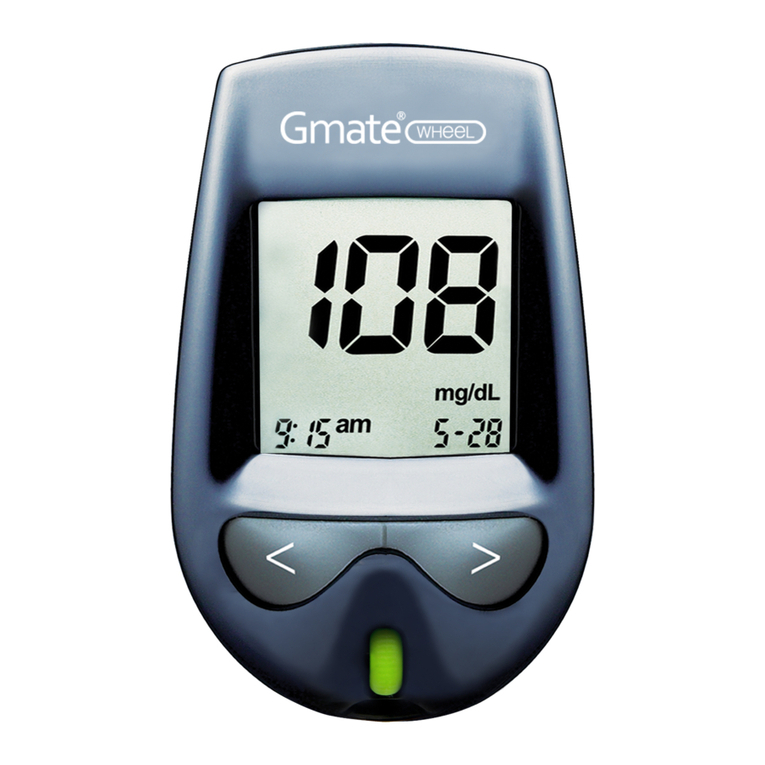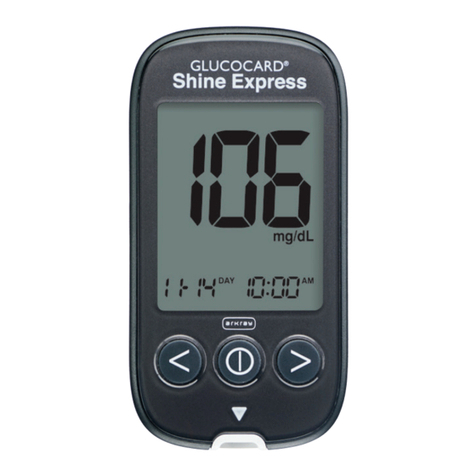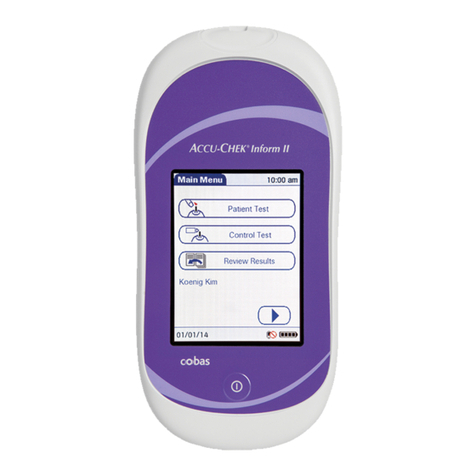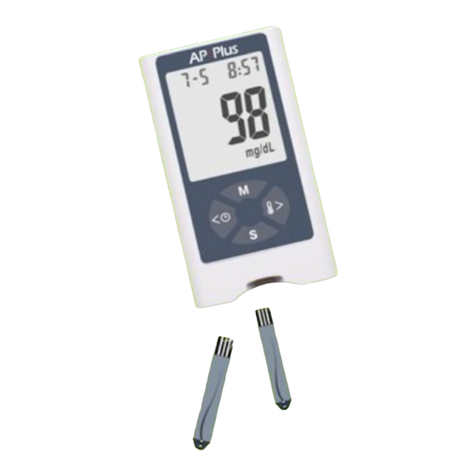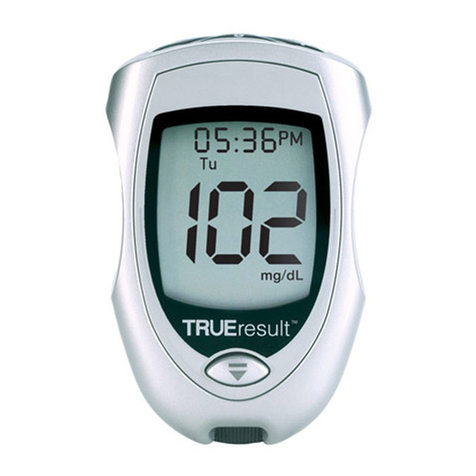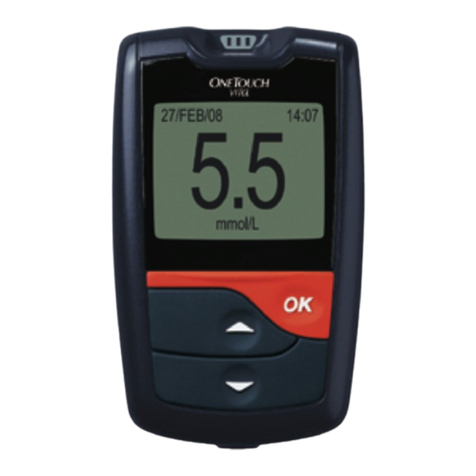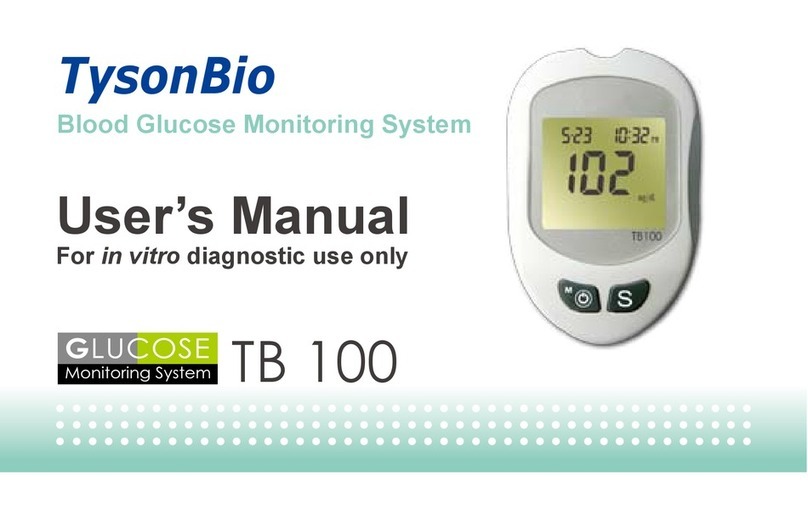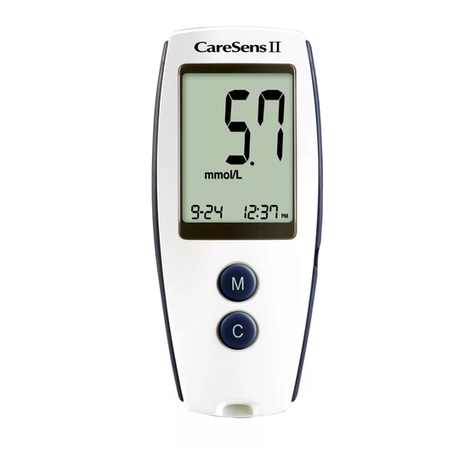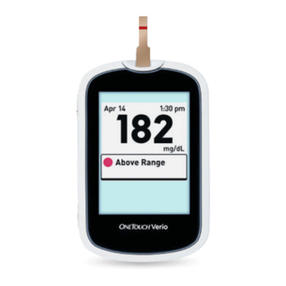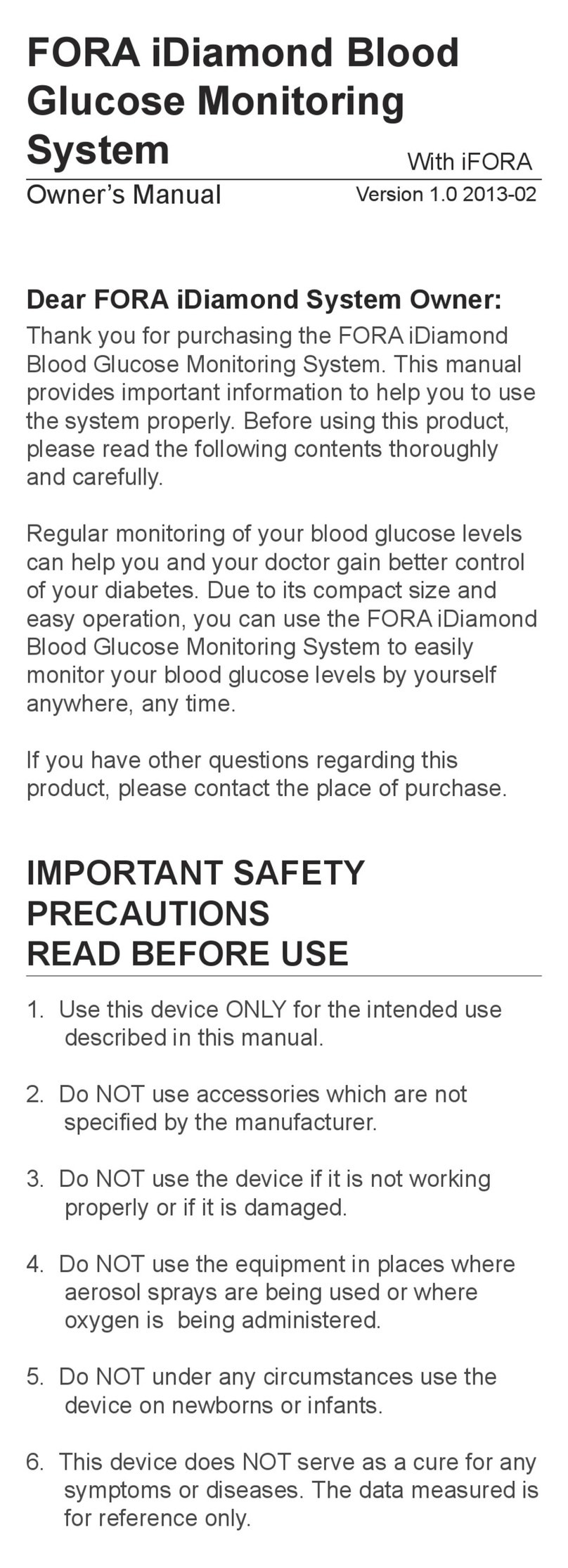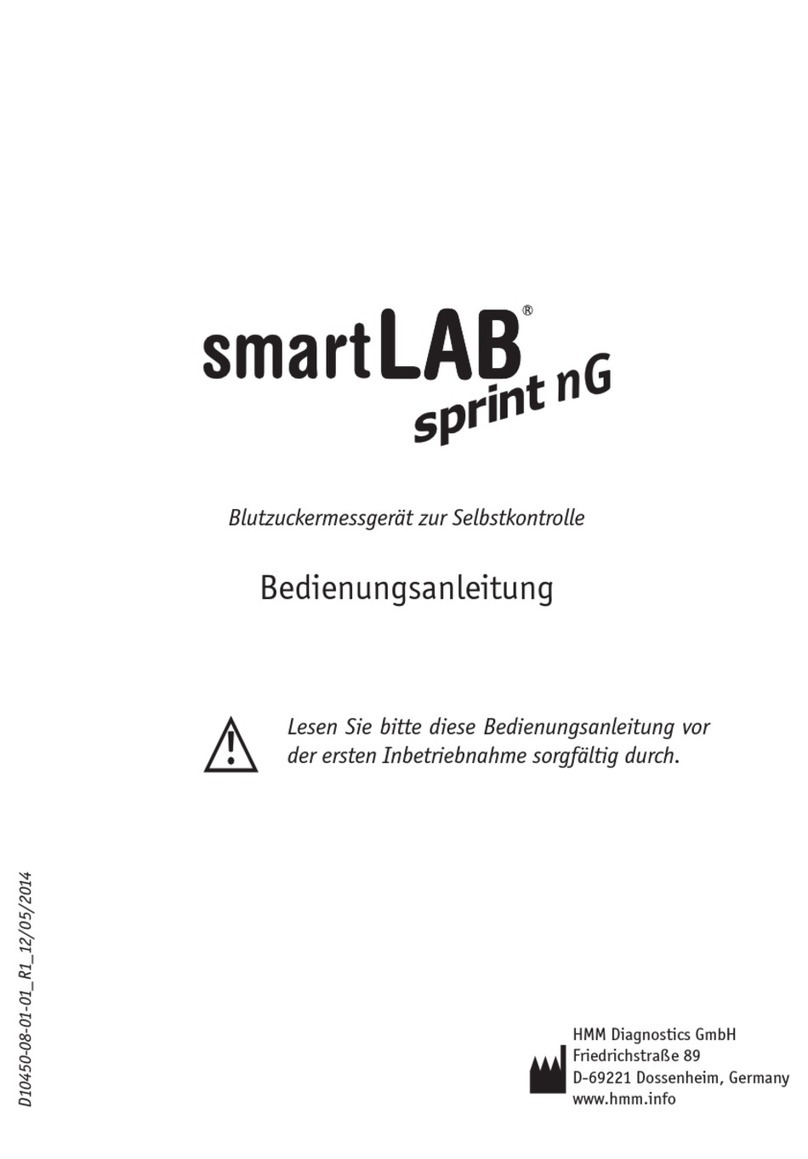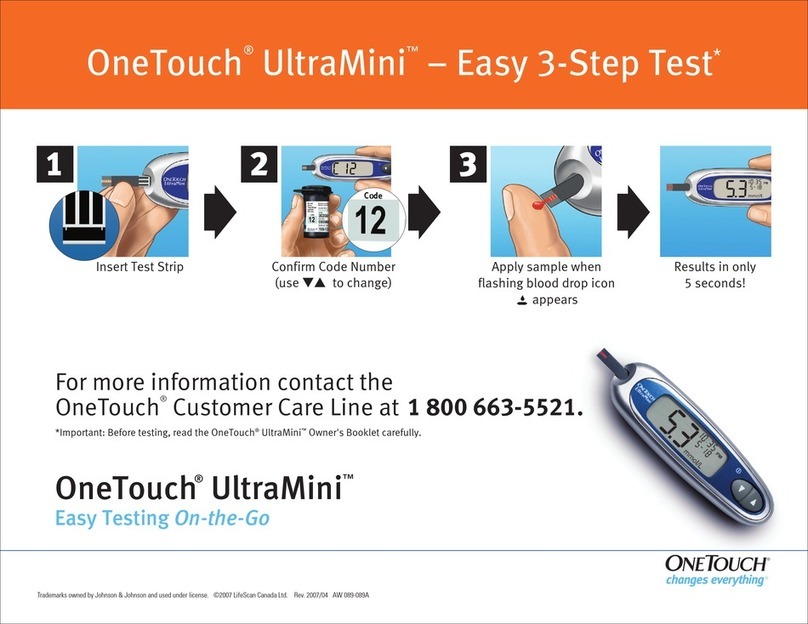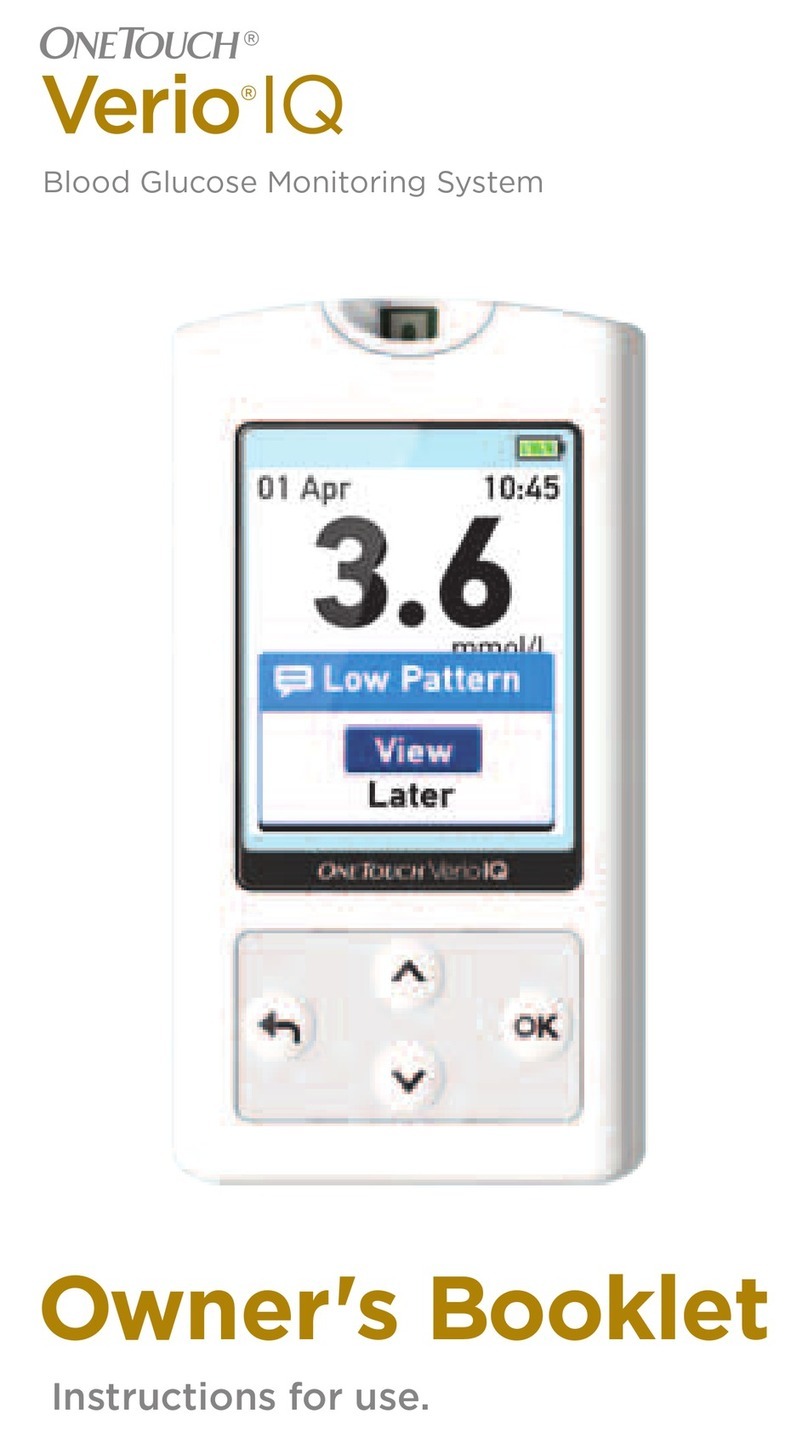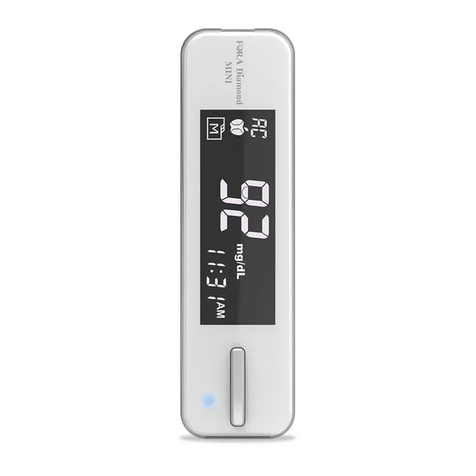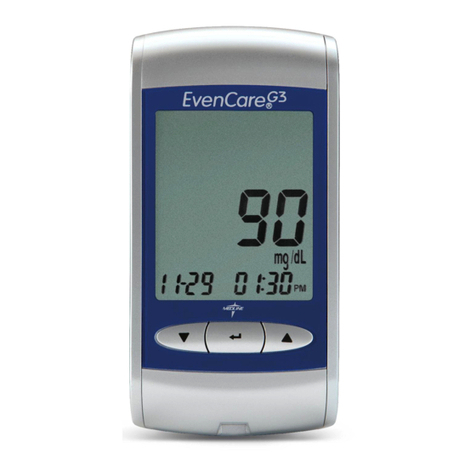Gmate Gmate Mini User manual

User's Guide
Thank you for purchasing the Gmate™
System.
Please read this User's Guide carefully
before using to ensure correct use.
Please keep this User's Guide for your
future reference.

Gmate™ System is very easy to carry around and able to be used
for measuring the glucose level in whole blood anytime.
It is also very simple, easy and foolproof. You don't have to worry
about coding your meter because the Gmate™ meter does it
automatically. The system should be used only for testing glucose
and only with fresh capillary whole blood samples. The system is
intended for self-testing by persons with use at home and in clinical
settings. It should not be used for the diagnosis of diabetes or the
testing of newborn.
Gmate™ meter has only one button to
navigate all functions easily with simple
operation.
It is small size, stylish design, and ease of
use allows you to take it everywhere.
It can show all information variously.
It requires very small volume(0.5uL) and
display the result in 5 seconds.
It can measure glucose in whole blood at
AST(Alternate site testing).
It can measure glucose concentration when
the test strip inserted without changing the
code number or using the code chip.
1
2
3
4
5
6
Features

Table of Contents
About Gmate™ System 4
Before Starting 5
Name and Function of the Parts 7
Cautions 10
Obtaining Blood Drop 13
About Alternate Site Testing 16
Testing Your Blood Glucose 18
Control Solution Testing 22
Reviewing Results 25
Setting the Meter 27
Replacing the Battery 30
Error Messages 31
Troubleshooting 33
Performance Characteristics 34
Caring for System 36
Specifications 38

4
About GmateTM System
Gmate™ System includes:

5
Before Starting
Symbols
Caution, see instructions for use
Single use only
Expiration date
Serial number
Lot number
In Vitro Diagnostic medical device
Manufacturer
Authorised representative
Symbol for temperature limitation
Consult instructions for use
Biological risks
Contains sufficient for <n> tests
Direct current
Separate disposal from other household waste

6
Before Starting
Intended Use
Gmate™ system is intended for self-testing to monitor glucose
concentrations in fresh whole blood. Gmate™ system is for use
outside body(in vitro diagnostic use) in fingertips, forearm, upper
arm, hand, thigh and calf testing.
Test principle
The Gmate™ system is based on measurement of a small electrical
current produced by the reaction of glucose in the blood sample with
the reagents on the strip. This current changes with the amount of
glucose in the blood sample. The glucose concentration in the
sample is calculated based on the electrical current and displayed on
the meter.
Setting the time and date
Your Gmate™ meter comes with the time, date, year and unit of
measure pre-set. Before using your meter for the first time or if you
change the meter battery, you should check and set the time and
date. If you does not set your meter for the first time or after changing
the battery, you can hear beep 3 times when inserting a test strip.
See the 27 page(Setting the Meter) to ensure your desired settings
are saved.

7
Names and Functions of the Parts
Front View
Gmate™ Test Strip
Display Screen
This is where you read your test results
and other informations.
M-button
The 'M' button is used to recall the
stored results and adjust the
parameters in set-up mode. You can
turn the meter off by pressing and
holding the 'M' button for 2 seconds.
Test Strip Port
Insert the end of a Gmate™ test strip
here. The meter will turn on when you
insert the test strip.
Electrodes
The end of the test strip is inserted into
the test strip port of the meter with this
end facing up.
Sample Tip
The end of the test strip where the
blood sample is drawn into.

8
Names and Functions of the Parts
Side View
Back View
Strap Hole
It is for hand-strap or neck-strap.
Battery Cover
Slide cover off to
replace batteries.
SET Button
Used to enter the set-
up mode for changing
the date and time and
unit of measure.

9
Names and Functions of the Parts
Display
Lancing Device
Displays the mode of meter.
Warns when the battery is low or must
be replaced.
Display test results, measuring status,
error messages and other
informations.
Results are displayed along with the
units of measure.
Clear AST cap
Lancet ejector Sliding barrel
Adjustable cap Lancet holder Release button
*Clear AST cap is an optional accessory.
Please contact your local distributor.

10
Cautions
Cautions for
System
The Gmate™ System is intended for use
outside the body(in vitro diagnostic use) only.
The Gmate™ System is used only for
measuring fresh capillary whole blood.
The Gmate™ meter should only be used with
Gmate™ Test Strip and Gmate™ Control
Solution.
Do not use the Gmate™ System for the
diagnosis of diabetes, testing on newborns
and testing of arterial blood.
The Gmate™ System contains small parts
that may be dangerous if swallowed.
Check the package before starting the
measurement.
Be sure to read user's guide and the test strip
insert found in the test strip box carefully
before testing.
Do not make any decision of medical
relevance without first consulting your
physician and/or having received appropriate
training.

11
Cautions
Cautions for
Meter
Keep the meter out of reach of young
children. If a young child swallows battery,
battery cover, immediately consult with a
doctor.
Do not swing the meter by holding the
neckstrap. You may injure yourself or other
people.
Do not throw the battery into fire.
Do not disassemble or modify the meter.
Do not subject the meter to severe shock,
drop or step on meter.
The meter is not waterproof. Do not wash it
or touch it with wet hands.
Do not wipe the meter with thinner, or
abrasive cleaners.
Avoid the meter being exposed to high
temperature, high humidity, rain and/or dust
when using or storing the meter.
Do not test glucose instantly when the meter
move to a place where it is a sudden change
in temperature. Wait 20 minutes and start
testing.

12
Cautions
Cautions for
Test Strip
Store the test strip in a cool, dry place
between 2° and 32°C(36° and 90°F).
Keep away from direct sunlight and heat.
After removing test strip from the vial,
immediately close the vial cap tightly.
You may get the inaccurate result if vial cap
opened long period of time.
Don't drop the blood on the surface of test
strip directly.
Do not press the test strip against your finger.
This may affect inaccurate aspiration of
blood.
Do not use a test strip that appears damaged
or has been used. Test strips are for single
use only.
Store test strips in their original vial.
After you take a test strip out of the vial, be
sure to use it within three minutes.
Always use test strips within 3
months(90days) after first opening.
With clean, dry hands, you may touch the
test strip anywhere when removing it from the
vial or inserting it into the meter.
Do not bend, cut, or alter test strips.

13
Obtaining Blood Drop
STEP 1
Wash your hands carefully with warm water
to increase the circulation of the blood into
the fingers. Dry hands thoroughly until the
finger to be pricked is completely dry.
STEP 2
Unscrew the cap of the lancing device by
turning it counter-clockwise while holding the
base firmly.

14
Obtaining Blood Drop
STEP 3
While holding the lancet carrier, insert a new
sterile lancet into the bottom of lancet carrier.
STEP 4
Twist the cap of the lancet off.
STEP 5
Put the cap of the lancing device back on
and turn it clockwise.
STEP 6
Hold the tip firmly in one hand then pull out
the sliding barrel with the other hand. This
will cock the lancing device.

15
Obtaining Blood Drop
STEP 7
Set the proper depth of penetration by
rotating the cap of lancing device. 1-2 for soft
or thin skin, 3 for average skin, 4-5 for thick
or calloused skin.
STEP 8
Place the lancing device in place. Hold the
lancing device firmly against the side of the
finger, with the cap resting on the finger.
(The harder it is pressed the deeper the
puncture). Press the release button to take a
sample.
Caution : To reduce the chance of infection :
Make sure to wash the puncture site with soap and water
before sampling.
Do not share a lancet or a lancing device with anyone.
Always use a new lancet - lancets are for single use only.
Keep your meter and lancing device clean.

16
About Alternate Site Testing
The Gmate™ Meter lets you obtain a blood sample from your Upper
arm, Forearm, Hand, Thigh or Calf. Obtaining a drop of blood from
these “alternate site testing” may be less painful than a fingertip
sample. Following figure shows the areas where you can test with
the Gmate™ System. Avoid moles, veins, bones and tendons.
Consult to your healthcare professional before using alternate site
testing.
Upper Arm
Forearm
Hand
Fingertips
Thigh
Calf

17
About Alternate Site Testing
Caution : Do not test on alternate sites :
when you think your blood glucose level is changing rapidly,
such as within two hours of exercise, a rapid-acting insulin
injection or insulin pump bolus or within two hours after a meal.
if you are testing for hypoglycemia (low blood glucose) or if you
suffer from hypoglycemia unawareness.
Obtaining a blood sample from alternate sites is different than getting
a sample from fingertips.
After inserting a new sterile lancet into the
bottom of lancet carrier, put the clear AST
cap to the lancing device.
Place the lancing device on the skin in the
chosen site, press and hold the lancing
device continuously for a few seconds, then
push the release button to take a sample.
watch through the clear cap until a sufficient
blood sample is taken. If there is not enough
blood, gently massage the area until a
sufficient sample has been collected.

18
Testing Your Blood Glucose
STEP 1
Hold the test strip with the electrode end
facing up. Insert the electrode end into the
test strip port on the meter. Insert a new test
strip into the meter until it stops. The meter
will turn on.
STEP 2
Time will be displayed for a moment. Then
Code number and strip symbol will be
displayed. A strip symbol with filling blood will
appear letting you know the meter is ready to
test.
STEP 3
Make sure the code number showed on the
screen is same as the code number printed
on the test strip vial. If the code number on
the screen is different from the code number
printed on the strip vial, try to insert new strip.

19
Testing Your Blood Glucose
STEP 4
Bring tip of the test strip to lightly touch the
drop of blood. Hold until the Meter beeps.
Blood is automatically pulled into the test strip.
STEP 5
The Meter will now show counting progress
during 5 seconds.
STEP 6
The test result is complete when you hear
beeps. Your blood glucose test result is
shown on the display screen.
Important : The volume of blood sample
must be at least 0.5 microliter(real size" ").

20
Testing Your Blood Glucose
Caution :
If your test is above 600 mg/dL (33.3
mmol/L), "HIGH" will appear on the
display screen.
If your test result is lower than 10
mg/dL (0.6 mmol/L), "LOW" will appear
on the display screen.
Important : The meter turns off
automatically after one minute of nonuse.
When this happens, test results are still
saved in memory.
Caution :
Used test strips and lancets may be considered
biohazardous waste in your area. Be sure to follow
your local regulations for proper disposal.
STEP 7
To turn your Meter off, simply remove the
used test strip. The Meter turns off
automatically. Your test result will
automatically be stored in memory.
Table of contents
Other Gmate Blood Glucose Meter manuals
